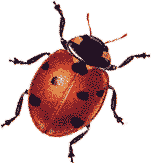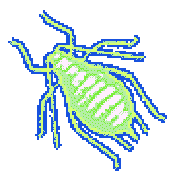|
from 2002 blue vol II |
|
|
 HAVE you noticed there appears to be a lot of aphids
hugging the stems of plants and precious few of their
predators - the hippodamia convergens, also known as
ladybirds, ladybugs and ladybeetles - hanging around?
You are more likely to find both aphid and ladybird in
organic gardens and farms, than among the edges of
monocultured fields where neetles are wont to grow
(home of both in early Spring). Perhaps the reason for
this is the advent of genetically modified plants,
perhaps not? In 1997 scientists in Scotland reported
that the ladybird might be one of the first victims of
GM crops. These scientists noted that the lifespan of
ladybirds was reduced to half when they ate aphids
that had fed on genetically altered potatoes in
Scotland. The ladybirds also laid fewer eggs.
The ladybird is a voracious carnivore - with aphids
their favourite food, though they will eat any
soft-bodied insect, particularly those which are
regarded as a pest of particular crops - such as
brassicae. The larvae of the ladybird feast on aphids
like they are about to go extinct.
HAVE you noticed there appears to be a lot of aphids
hugging the stems of plants and precious few of their
predators - the hippodamia convergens, also known as
ladybirds, ladybugs and ladybeetles - hanging around?
You are more likely to find both aphid and ladybird in
organic gardens and farms, than among the edges of
monocultured fields where neetles are wont to grow
(home of both in early Spring). Perhaps the reason for
this is the advent of genetically modified plants,
perhaps not? In 1997 scientists in Scotland reported
that the ladybird might be one of the first victims of
GM crops. These scientists noted that the lifespan of
ladybirds was reduced to half when they ate aphids
that had fed on genetically altered potatoes in
Scotland. The ladybirds also laid fewer eggs.
The ladybird is a voracious carnivore - with aphids
their favourite food, though they will eat any
soft-bodied insect, particularly those which are
regarded as a pest of particular crops - such as
brassicae. The larvae of the ladybird feast on aphids
like they are about to go extinct.
We have a wounded ladybird in our care. Somehow it has damaged one of its wings, so it presently chases around our herb pots in the kitchen, keeping the aphid population down. But when it tries to fly the machinery doesn't work, so it takes to its legs or remains still. It also gives us an opportunity to study this fascinating creature up close. The adult ladybird is about a quarter of an inch in size. A shell, coloured red or burnt orange, covers a body that has a matt black underbelly. This contracts when the ladybird believes itself in danger, and this delicate creature plays dead. A ladybird will also take to flight to escape danger. The shell opens to reveal folded flying wings which stand out at right angles. A ladybird may have two or more spots on its shell. When the ladybird is active its six legs carry it along stems and under leaves at a speed Michael Schumacher would find challenging in his red Ferrari. When the ladybird has an aphid in its mits, we see strong jaws under the distinctive black and white V-shaped head. Ladybirds are essential in an organic garden or farm - simply because they remove pests and do no damage at all to plants. Last summer we bought ladybird larvae and laid them on our young plants, but we also bought a dozen or so adults up on nettle stems gathered at the river bank. It was a deliberate strategy because the domestic organic garden will attract all manner of species and quite a few that will feast on domestic plants. Aphids thrive in a cultivated vegetable garden, which is why woodland gardens, with their multi-layered wild species, are necessary to encourage predators. We inherited a garden that had not been touched for 35 years but we feared the introduction of domestic vegetation would prove a treat for aphids until we had created the conditions for a woodland garden.
A few years ago I lost about 1000 herbs after an infestation of aphids, and as I planned a similar venture last year I wanted to keep the aphid population under control. The ladybirds were all stars. On one summer day I spotted about fifty hanging around. But I didn't take any chances. The nettles brought up from the river were added to a drum of water. Soaking stinging nettles in a pot of water for about 12 hours will produce a substance that, once sprayed on the infected plants, will act as an irritant to these persistent pests. We also made a tea from comfrey and used it as a fertiliser as well as a deterrent. And we'll have to do it all over again this year.
|
| We invite contributions to this page from organic and biological farmers and gardeners, permaculturalists, forest or woodland farmers and gardeners or anyone who has something to say about soil and seeds. Send to Newsdesk. |
|
BLUE is looking for short fiction, extracts of novels, poetry, lyrics,
polemics, opinions, eyewitness accounts, news, features, information and arts
in any form relating to eco cultural- social- spiritual issues, events and
activites (creative and political). Send to Newsdesk. |

 Aphids, however, are used to this assault on their
species. They survive simply because there are so many
of them. They can reproduce without the help of a
mate. It seems a single aphid can produce several
identical copies of itself in a day, all born alive
and all ready to reduce our plants to sad, wilted
pieces of greenery fit only for the compost heap.
According to Nicolas Lampkin the damage they cause to
a plant is not just from sucking the sap
"but also
because they produce a sugary honeydew which blocks
the plant's stomata (the cellular pores on the leaves
which control the passage of gases into and out of the
plant) and encourages the growth of fungi".
Aphids, however, are used to this assault on their
species. They survive simply because there are so many
of them. They can reproduce without the help of a
mate. It seems a single aphid can produce several
identical copies of itself in a day, all born alive
and all ready to reduce our plants to sad, wilted
pieces of greenery fit only for the compost heap.
According to Nicolas Lampkin the damage they cause to
a plant is not just from sucking the sap
"but also
because they produce a sugary honeydew which blocks
the plant's stomata (the cellular pores on the leaves
which control the passage of gases into and out of the
plant) and encourages the growth of fungi".